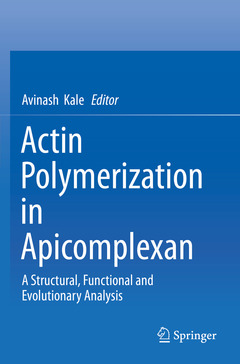Description
Actin Polymerization in Apicomplexan, 1st ed. 2019
A Structural, Functional and Evolutionary Analysis
Coordinator: Kale Avinash
Language: English
Subjects for Actin Polymerization in Apicomplexan:
Publication date: 11-2020
101 p. · 15.5x23.5 cm · Paperback
Publication date: 11-2019
101 p. · 15.5x23.5 cm · Hardback
Description
/li>Contents
/li>Biography
/li>Comment
/li>
This book discusses in detail the structural, evolutionary and functional role of actin and its regulatory proteins in gliding motility in apicomplexan organisms, a unique phenomenon found in actin-myosin cytoskeletal elements.
The book also explores the potential of different actin regulators, namely formin, profilin, actin depolymerization factor (ADF), capping proteins (CP? and CP?), cyclase-associated protein (CAP) and coronin 13?24 as potential drug targets against malaria. As the chief components of the gliding motor, the actin-regulator proteins are characterized by unique features that make them promising targets for structure-based drug design.
Lastly, the book proposes a mathematical model, based on kinetic data mining, to help understand the most vital regulators for actin polymerization dynamics.
Chapter 1. Synthesis and Characterization of nano Apicomplexan motility: A cellular perspective particles.- Chapter 2. Introduction: Gliding Motility- The model and the mechanism.- Chapter 3. Actin: The central ubiquitous player in the phenomenon.- Chapter 4. Formin: The multidomain elongator of polymer.- Chapter 5. Profilin: The associates of Formin.- Chapter 6. ADF (Actin Depolymerizing Factor): The breaker of the polymer in homeostasis.- Chapter 7. Cyclase associated protein (CAP): The silent worker.- Chapter 8. Capping Protein (CP): The formin competitor.- Chapter 9. Coronin: An Overview.- Chapter 10. Mathematical Model: A revelation of synergistic cross talks between the actin regulators.- Chapter 11. Evolution: The hallmarks of Gliding motility in apicomplexan.
Dr. Avinash Kale is a Reader at the School of Chemical Sciences, UM-DAE Centre for Excellence in Basic Sciences, Mumbai, India. His research interests are in the area of integrative structure biology and proteomics (ISBAP). He has more than 16 years of teaching experience in computational biology, biotechnology, molecular modeling and drug design, group theory, spectroscopy, and bioinformatics. He has served as a reviewer for a number of international journals, including the Journal of Biomolecular Structure and Dynamics (USA), and Nature Scientific Reports (USA).
Reviews the mechanism of gliding motility in apicomplexan organisms
Discusses the structural, evolutionary, and functional role of actin-regulatory proteins
Introduces a mathematical model to help understand the role of actin-regulatory proteins in motility
Explores the potential of actin and its regulatory proteins as potential drug targets against apicomplexan organisms
These books may interest you

The Actin Cytoskeleton 295.39 €



